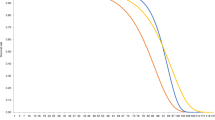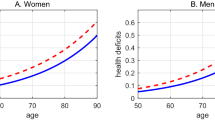Abstract
Improvements in life expectancy among high-income countries are increasingly occurring in later years. Efforts to exploit the malleability of age and the additional time longevity brings are already underway, but important roadblocks remain. This article discusses the socioeconomic concept of the longevity dividend, in which healthy and productive aging is achieved through a positive correlation between three dimensions: life expectancy, health and the economy. Investing in a longevity dividend is needed to offset the economic challenges of an aging society and embrace a new life course, but this requires deep-seated changes in individual behavior and corporate and government policies. Focusing on treatments that target delayed aging, supporting employment beyond 50 years of age and tackling ageism are key priorities.
This is a preview of subscription content, access via your institution
Access options
Access Nature and 54 other Nature Portfolio journals
Get Nature+, our best-value online-access subscription
$29.99 / 30 days
cancel any time
Subscribe to this journal
Receive 12 digital issues and online access to articles
$119.00 per year
only $9.92 per issue
Buy this article
- Purchase on Springer Link
- Instant access to full article PDF
Prices may be subject to local taxes which are calculated during checkout



Similar content being viewed by others
References
Oeppen, J. & Vaupel, J. W. Broken limits to life expectancy. Science 296, 1029–1031 (2002).
Vaupel, J. W., Villavicencio, F. & Bergeron-Boucher, M.-P. Demographic perspectives on the rise of longevity. Proc. Natl Acad. Sci. USA 118, e2019536118 (2021).
Bloom, D. E. & Canning, D. The health and wealth of nations. Science 287, 1207–1209 (2000).
Deaton, A. The Great Escape: Health, Wealth and the Origins of Inequality (Princeton University Press, 2013).
Eggleston, K. & Fuchs, V. The new demographic transition: most gains in life expectancy now realised late in life. J. Econ. Perspect. 26, 137–156 (2012).
Olshansky, S. J., Perry, D., Miller, R. A. & Butler, R. N. Pursuing the longevity dividend: scientific goals for an aging world. Ann. NY Acad. Sci. 1114, 11–13 (2007).
Cooley, T. & Henriksen, E. The demographic deficit. J. Monetary Econ. 93, 45–62 (2018).
Aksoy, Y., Basson, H., Smith, R. & Grasi, T. Demographic structure and macroeconomic trends. Am. Econ. J. Macroecon. 11, 193–222 (2019).
Carvalho, C., Ferrero, A. & Nechio, F. Demographics and real interest rates: inspecting the mechanism. Eur. Econ. Rev. 88, 208–226 (2016).
Bloom, D. E., Chen, S., Kuhn, M. & Prettner, K. The flip side of ‘live long and prosper’: noncommunicable diseases in the OECD and their macroeconomic impact. in Live Long and Prosper? The Economics of Ageing Populations (ed. Bloom, D. E.) 44–52 (CEPR, 2019); https://voxeu.org/content/live-long-and-prosper-economics-ageing-populations
Bloom, D. E., Khoury, A., Algur, E. & Sevilla, J.-P. Valuing productive non-market activities of older adults in Europe and the US. Economist (Leiden) 168, 153–181 (2020).
Levine, M. E. & Crimmins, E. M. Is 60 the new 50?: examining changes in biological age over the past two decades. Demography 55, 387–402 (2018).
Abelianksy, A. L., Erel, D. & Strulik, H. Aging in the USA: similarities and disaparities across time and space. Sci. Rep. 10, 14309 (2020).
GBD 2019 Demographics Collaborators. Global age-sex-specific fertility, mortality, healthy life expectancy (HALE), and population estimates in 204 countries and territories, 1950–2019: a comprehensive demographic analysis for the Global Burden of Disease Study 2019. Lancet 396, 1160–1203 (2020).
Fries, J. Aging, natural death, and the compression of morbidity. N. Engl. J. Med. 303, 130–135 (1980).
Scott, A. J., Ellison, M. & Sinclair, D. A. The economic value of targeting aging. Nat. Aging https://doi.org/10.1038/s43587-021-00080-0 (2021).
Ekerdt, D. J. et al. Is longevity a value for older adults? J. Aging Stud. 43, 46–52 (2017).
Chetty, R. et al. The association between income and life expectancy in the United States, 2001–2014. JAMA 315, 1750–1766 (2016).
Case, A. & Deaton, A. Deaths of Despair and the Future of Capitalism (Princeton University Press, 2020).
Marmot, M. & Allen, J. J. Social determinants of health equity. Am. J. Public Health 104, S517–S519 (2014).
Crimmins, E. Lifespan and healthspan: past, present and promise. Gerentologist 55, 901–911 (2015).
Campisi, J. et al. From discoveries in aging research to therapeutics for healthy aging. Nature 571, 183–192 (2019).
Barzilai, N. Age Later : Healthspan, Lifespan and the New Science of Longevity (St Martins, 2020).
Sinclair, D. A. Lifespan: Why We Age and Why We Don’t Have To (Thorsons, 2019).
Goldman, D. P. et al. Substantial health and economic returns from delayed aging may warrant a new focus for medical research. Health Aff. 32, 1698–1705 (2013).
García, J.-L., Heckman, J. J., Leaf, D. E. & Prados, M.-J. Quantifying the life-cycle benefits of an influential early childhood program. J. Political Econ. 128, 2502–2541 (2020).
Geelhoed, E., George, P., Clark, K. & Strahan, K. Health population aging depends on investment in early childhood learning and development. in Live Long and Prosper? The Economics of Aging Populations (ed. Bloom, D. E.) 105–110 (VoxEU.org, 2019).
Gomez, L. E. & Benert, P. Diversity improves performance and outcomes. J. Natl Med. Assoc. 111, 383–392 (2019).
Heckman, J. J. The economics, technology and neuroscience of human capability formation. Proc. Natl Acad. Sci. USA 104, 13250–13255 (2007).
Coughlin, J. F. The Longevity Economy: Inside the World’s Fastest-Growing, Most Misunderstood Market (Public Affairs, 2017).
Zhavoronkov, A., Bischof, E. & Lee, K.-F. Artificial intelligence in longevity medicine. Nat. Aging 1, 5–7 (2021).
Scott, A. J. A longevity dividend versus an aging society. in Live Long and Prosper? The Economics of Aging Populations (ed. Bloom, D. E.) 81–91 (Voxeu.org, 2019).
Murphy, K. M. & Topel, R. H. The value of health and longevity. J. Political Econ. 114, 871–904 (2006).
Ben-Porath, Y. The production of human capital and the life cycle of earnings. J. Political Econ. 75, 352–365 (1967).
Soares, R. Mortality reductions, educational attainment and fertility choice. Am. Econ. Rev. 95, 580–601 (2005).
Kalemili-Ozcan, S. & Weil, D. N. Mortality change, the uncertainty effect and retirement. J. Econ. Growth 15, 65–91 (2010).
Prettner, K. & Canning, D. Increasing life expectancy and optimal retirement in general equilibrium. Econ. Theory 56, 217–243 (2014).
Dragone, D. & Strulik, H. Negligible senescence: an economic life cycle model for the future. J. Econ. Behav. Org. 171, 264–285 (2020).
Costa, D. The Evolution of Retirement: An American Economic History (University of Chicago Press, 1998).
Bloom, D. E., Canning, D. & Moore, M. Optimal retirement with increasing longevity. Scand. J. Econ. 116, 838–858 (2014).
Allen, S. G. Demand for older workers: what do economists think? What are firms doing? Discussion paper 26597 https://www.nber.org/system/files/working_papers/w26597/w26597.pdf (National Bureau of Economic Research, 2019).
Neumark, D., Burn, I. & Button, P. Is it harder for older workers to find jobs? New and improved evidence from a field experiment. J. Political Econ. 127, 922–970 (2019).
Conley, C. Wisdom@Work: The Making of a Modern Elder (Portfolio Penguin, 2018).
Suh, J. Y. Age discrimination in the workplace hurts us all. Nat. Aging 1, 147 (2021).
Acemoglu, D. & Restrepo, P. Demographics and automation. Rev. Econ. Studies (in the press).
Börsch-Supan, A. & Matthias, W. Productivity and age: evidence from work teams at the assembly line. J. Econ. Aging 7, 30–42 (2016).
Maestres, N., Mullen, K., Powell, D., Wachter, T. V. & Wenger, J. B. The value of working conditions in the United States and implications for the structure of wages. Working paper 25204 https://www.nber.org/system/files/working_papers/w25204/w25204.pdf (National Bureau of Economic Research, 2018).
Ameriks, J. et al. Older Americans would work longer if jobs were flexible. Am. Econ. J. Macroecon. 12, 174–209 (2020).
Laun, L. The effect of age-targeted tax credits on labor force participation of older workers. J. Public Econ. 152, 102–118 (2017).
Azoulay, P., Jones, B. F., Kim, J. D. & Miranda, J. Age and high-growth entrepreneurship. Am. Econ. Rev. Insights 2, 65–82 (2020).
Hazan, M. Longevity and lifetime labor supply: evidence and implications. Econometrica 77, 1829–1863 (2009).
Dede, C. & Richards, J. The 60 Year Curriculum: New Models for Lifelong Learning in the Digital Economy (Routledge, 2020).
Palladino, G. Teenagers: An American History (Basic Books, 1997).
Savage, J. Teenage: The Creation of Youth 1875–1945 (Pimlico Books, 2008).
Graebner, W. A History of Retirement: The Meaning and Function of an American Institution 1885–1978 (Yale University Press, 1980).
Macnicol, J. The Politics of Retirement in Britain 1878–1948 (Cambridge University Press, 1998).
Dixit, A. & Pindyck, R. Investment under Uncertainty (Princeton University Press, 1994).
Gratton, L. & Scott, A. The 100 Year Life—Living and Working in an Age of Longevity (Bloomsbury Press, 2016).
Gratton, L. & Scott, A. The corporate implications of longer lives. Sloan Management Review https://sloanreview.mit.edu/article/the-corporate-implications-of-longer-lives/ (1 March 2017).
Thomas, K. Age and authority in early modern england. Proc. Br. Acad. 62, 205–248 (1976).
Horvath, S. DNA methylation age of human tissues and cell types. Genome Biol. 14, 3156 (2013).
Shoven, J. & Goda, G. S. Adjusting government policies for age inflation. in Demography and the Economy (ed. Shoven, J.) 143–168 (University of Chicago Press, 2011).
Sanderson, W. & Scherbov, S. Prospective Longevity—A New Vision of Population Aging (Harvard University Press, 2019).
Acknowledgements
Funding from ESRC research grant T002204 is gratefully acknowledged, as well as comments from M. Ellison, G. Mellior and D. Miles.
Author information
Authors and Affiliations
Corresponding author
Ethics declarations
Competing interests
A.J.S. is a cofounder of the Longevity Forum, an advisor to Genflow BioSciences, has acted as a consultant for GlaxoSmithKline and the United Nations on issues of longevity, and is a member of the World Economic Forum’s Healthy Ageing and Longevity Global Future Council.
Additional information
Peer review information Nature Aging thanks Joseph Coughlin and Linda Fried for their contribution to the peer review of this work.
Publisher’s note Springer Nature remains neutral with regard to jurisdictional claims in published maps and institutional affiliations.
Source data
Source Data Fig. 1
Statistical source data.
Source Data Fig. 2
Statistical source data.
Source Data Fig. 3
Statistical source data.
Rights and permissions
About this article
Cite this article
Scott, A.J. Achieving a three-dimensional longevity dividend. Nat Aging 1, 500–505 (2021). https://doi.org/10.1038/s43587-021-00074-y
Received:
Accepted:
Published:
Issue Date:
DOI: https://doi.org/10.1038/s43587-021-00074-y



